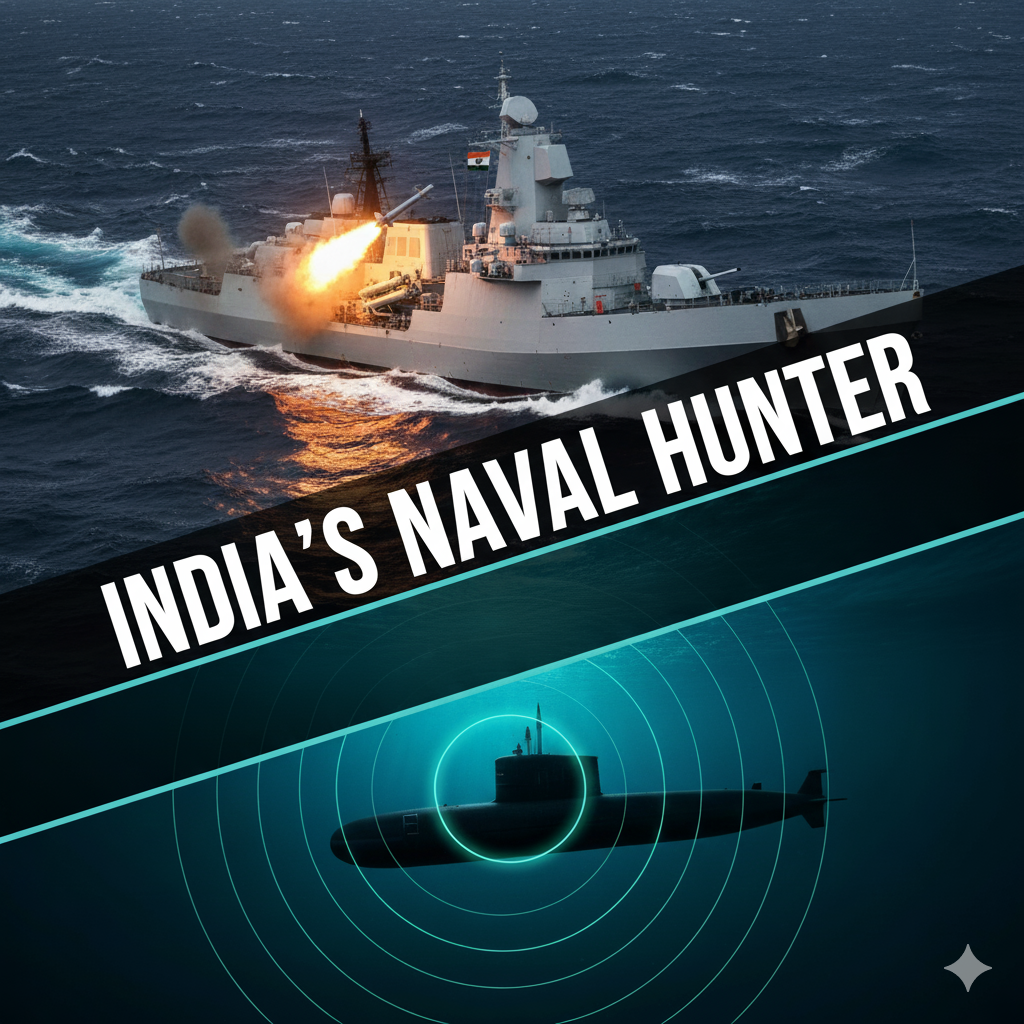Key Highlights
- INS Androth commissioned October 6, 2025 – India’s second indigenous Anti-Submarine Warfare Shallow Water Craft with over 80% indigenous content
- Largest diesel-waterjet warship in Indian Navy at 77.6 meters length, capable of 25 knots maximum speed and 1800 nautical mile endurance
- Advanced ASW capabilities include Low Frequency Variable Depth Sonar, lightweight torpedoes, indigenous ASW rockets, and mine-laying systems
- Strategic deterrent against China-Pakistan submarine threats in Indian Ocean, with continuous ASW patrols maintaining underwater domain awareness
- Make in India success story – part of 16-vessel ASW-SWC project replacing aging Abhay-class corvettes, demonstrating India’s shipbuilding self-reliance
The commissioning of INS Androth on October 6, 2025, at Visakhapatnam Naval Dockyard represents more than just another warship joining India’s fleet. It signals a fundamental shift in how India projects naval power in the Indian Ocean Region, where underwater threats from China and Pakistan are intensifying at an unprecedented pace.
The Strategic Context: Why ASW Matters
India’s 7,500-kilometer coastline faces evolving maritime challenges that traditional surface vessels cannot adequately address. The emergence of sophisticated submarine capabilities among regional adversaries has created what naval strategists call the “underwater dilemma” – the need to detect, track, and neutralize threats beneath the surface before they can threaten critical infrastructure. rnamedia
China’s expanding submarine presence in the Indian Ocean, including Type-093B SSNs and advanced unmanned underwater vehicles, has fundamentally altered the strategic calculus. Meanwhile, Pakistan’s acquisition of eight Chinese Type-039B Hangor-class submarines adds another layer of complexity to India’s maritime security challenges.
The geographic advantage India possesses – sitting astride major sea lanes connecting the Pacific and Atlantic – becomes meaningless if hostile submarines can operate undetected in these waters. This reality has driven India’s comprehensive ASW modernization, with vessels like INS Androth serving as the frontline guardians of Indian maritime sovereignty.
INS Androth: Technical Marvel and Strategic Asset
Revolutionary Design Features
Built by Garden Reach Shipbuilders & Engineers (GRSE) in Kolkata, INS Androth embodies cutting-edge naval engineering tailored specifically for Indian Ocean conditions. At 77.6 meters length and 900 tonnes displacement, the vessel represents the largest diesel-waterjet combination warship ever built by India. pib
The waterjet propulsion system provides crucial advantages in shallow water operations, enabling the vessel to operate effectively in waters less than 30 meters deep – precisely where Pakistani submarines might attempt coastal infiltration. This capability creates what naval analysts term a “denial zone” along India’s littoral waters.
Advanced Sensor Suite
The vessel’s sensor capabilities represent a quantum leap in indigenous technology development. The Low Frequency Variable Depth Sonar (LFVDS) provides extended detection ranges, while the Hull-Mounted Sonar Abhay offers comprehensive underwater surveillance. These systems, integrated with the Underwater Acoustic Communication System (UWACS), create a networked underwater awareness grid.
The Expandable Bathy Thermograph (XBT) system enables real-time ocean condition analysis, crucial for optimizing sonar performance in varying underwater environments. This technological sophistication ensures that INS Androth can operate effectively across the diverse oceanographic conditions found throughout the Indian Ocean.
Weapons Systems and Combat Capabilities
INS Androth’s weapons suite reflects India’s growing indigenous defense capabilities. The vessel carries twin triple-tube lightweight torpedo systems, specifically designed for shallow water engagements. The indigenous ASW rockets represent a significant milestone in India’s underwater weapons development, reducing dependence on foreign systems.
The 30mm Close-In Weapon System (CIWS) with electro-optical fire control provides defense against aircraft and surface threats, while the twin 12.7mm stabilized gun system offers precision engagement capabilities. The vessel can also deploy sea mines, creating defensive barriers around critical naval bases and commercial ports.
The Arnala-Class Project: India’s ASW Revolution
Scale and Scope
INS Androth belongs to the Arnala-class of eight vessels being built by GRSE, part of a larger 16-vessel ASW-SWC program that includes eight additional vessels from Cochin Shipyard Limited. This represents India’s most ambitious coastal defense shipbuilding program, designed to replace the aging Abhay-class ASW corvettes commissioned in the 1980s. gsre
The total project value exceeds $2 billion, making it one of India’s largest indigenous naval programs. The systematic replacement of legacy platforms with modern, indigenous vessels demonstrates India’s commitment to maintaining technological superiority in its maritime domain.
Indigenous Content Achievement
The program’s success in achieving over 80% indigenous content represents a paradigm shift in Indian defense manufacturing. Major Indian defense firms contributing to the project include Bharat Electronics Limited (BEL), Larsen & Toubro, Mahindra Defence, and MEIL. This high indigenization level reduces lifecycle costs while ensuring uninterrupted maintenance and upgrades.
The program has engaged over 55 Micro, Small, and Medium Enterprises (MSMEs), creating a robust supply chain ecosystem. This approach aligns with the government’s broader strategy of developing indigenous defense manufacturing capabilities while generating employment across multiple states. pib
Operational Significance in Current Threat Environment
Countering Chinese Naval Expansion
China’s “String of Pearls” strategy in the Indian Ocean includes naval facilities at Djibouti, Gwadar, and the recently operationalized BNS Sheikh Hasina submarine base in Bangladesh. These developments enable sustained Chinese naval presence in waters traditionally considered India’s sphere of influence.
Indian naval analysts estimate that China could maintain continuous deterrence patrols across key maritime choke points by 2030, fundamentally altering the regional balance of power. INS Androth and similar vessels serve as persistent underwater sentinels, ensuring that any foreign submarine activity is detected and tracked. defencesecurityasia
The vessel’s 1800 nautical mile endurance at 14 knots enables extended patrols covering critical sea lanes from the Strait of Hormuz to the Malacca Strait. This capability ensures continuous monitoring of potential Chinese submarine transit routes.
Pakistan Maritime Challenge
Pakistan’s eight Chinese-built Hangor-class submarines represent a significant capability enhancement, particularly their air-independent propulsion systems that enable extended underwater operations. These vessels can potentially threaten India’s western coastline and disrupt maritime trade routes in the Arabian Sea. indiasentinals
INS Androth’s shallow water capabilities are specifically designed to counter this threat. Pakistani submarines approaching India’s coast must traverse shallow continental shelf waters where conventional ASW platforms face detection challenges. The vessel’s specialized sonar systems and waterjet propulsion overcome these limitations.
The coordinated ASW operations capability allows INS Androth to work seamlessly with Boeing P-8I Poseidon aircraft and MH-60R Seahawk helicopters, creating a comprehensive detection and engagement grid.
Make in India: Defense Manufacturing Success Story
Industrial Ecosystem Development
The ASW-SWC program exemplifies the Make in India initiative’s success in defense manufacturing. GRSE’s achievement of 90% indigenous content in recent corvette programs established the foundation for the current ASW-SWC success. The company has developed comprehensive vendor networks, with 36% of procurement value sourced from SMEs annually.
The program’s Public-Private Partnership model with Larsen & Toubro’s Kattupalli Shipyard demonstrates effective collaboration between public sector shipyards and private industry. This approach combines GRSE’s design expertise with L&T’s modern manufacturing capabilities.
Technology Transfer and Innovation
GRSE has established strategic partnerships for technology development, including a Memorandum of Understanding with Elbit Systems for Unmanned Surface Vessel development and collaboration with MTU Germany for indigenous engine manufacturing. These partnerships ensure technology transfer while building indigenous capabilities.
The development of indigenous warship-grade steel DMR 249A by Steel Authority of India Limited represents another technological milestone. This achievement reduces dependence on imported specialized materials while ensuring quality standards for naval applications.
Regional Implications and Strategic Balance
Indian Ocean Security Architecture
INS Androth’s commissioning contributes to India’s broader strategy of maintaining maritime domain awareness across the Indian Ocean Region. The vessel’s capabilities complement India’s expanding network of coastal radar systems, underwater surveillance arrays, and satellite monitoring systems.
The integration with India’s proposed National Underwater Domain Awareness (NUDA) Project will enhance threat detection through AI-assisted sonar analytics and autonomous underwater drones. This creates an intelligent, networked maritime grid capable of real-time threat assessment.
Deterrence and Escalation Control
The vessel’s rapid response capabilities enable what naval strategists term “escalation control” – the ability to demonstrate resolve without triggering broader conflict. INS Androth can shadow potentially hostile submarines, gather intelligence, and signal India’s awareness of their presence without necessarily escalating to engagement.
This capability is particularly valuable in the complex multipolar environment of the Indian Ocean, where Chinese, Pakistani, and other foreign naval forces operate alongside Indian vessels. The ability to maintain underwater awareness without immediate confrontation provides diplomatic flexibility.
Future Prospects and Technological Evolution
Next-Generation ASW Capabilities
The ASW-SWC program represents the foundation for India’s future underwater warfare capabilities. The Indian Navy is already planning integration of artificial intelligence and unmanned systems into ASW operations. Future vessels may incorporate autonomous underwater vehicles (AUVs) for extended surveillance missions.
The development of indigenous submarine detection algorithms and networked sensor systems will enhance the collective capabilities of the ASW-SWC fleet. These technological advances ensure that India remains ahead of evolving submarine threats.
Export Potential and International Cooperation
India’s success in indigenous ASW vessel development creates opportunities for defense exports to friendly nations. Countries in the Indo-Pacific region facing similar submarine threats may seek Indian-built ASW platforms, supporting the government’s “Make in India – Make for World” vision.
Potential customers include Bangladesh, Sri Lanka, Mauritius, and Seychelles – nations that lack sophisticated ASW capabilities but face growing submarine activity in their waters. Export success would validate India’s technological achievements while generating revenue for continued research and development.
Way Forward: Strengthening India’s Underwater Defense Grid
Immediate Priorities
The remaining six ASW-SWC vessels under construction must maintain delivery schedules to ensure complete coastal coverage. Integration training for naval personnel and coordination exercises with air and submarine assets will maximize operational effectiveness.
Development of forward logistics nodes in the Seychelles, Oman, and potentially Indonesia will extend operational range and persistence. These facilities would enable sustained ASW patrols across critical sea lanes.
Long-term Strategic Vision
India’s ultimate objective involves transitioning from coastal ASW capabilities to expeditionary underwater warfare systems. The experience gained from ASW-SWC operations will inform future programs including nuclear-powered attack submarines under Project-77.
Integration with allied naval forces through the Quadrilateral Security Dialogue (QUAD) and bilateral partnerships will create comprehensive underwater surveillance networks. Shared intelligence and coordinated patrols multiply the effectiveness of individual platforms.
The commissioning of INS Androth represents more than a single vessel joining India’s fleet – it symbolizes a fundamental transformation in how India approaches maritime security in an increasingly contested Indo-Pacific region. With over 80% indigenous content and cutting-edge ASW capabilities, the vessel demonstrates that India has successfully transitioned from a buyer to a builder of sophisticated naval platforms.
As China expands its submarine presence through the “String of Pearls” strategy and Pakistan enhances its underwater capabilities with Chinese assistance, India’s response through programs like ASW-SWC ensures that the Indian Ocean remains secure for legitimate maritime activities while deterring potential adversaries.
The success of indigenous shipbuilding programs like ASW-SWC proves that India’s vision of becoming a maritime power backed by self-reliant defense manufacturing is not just an aspiration but an achievable reality. With 14 more vessels in various stages of construction and plans for next-generation capabilities, India’s underwater defense grid will only grow stronger.









+ There are no comments
Add yours